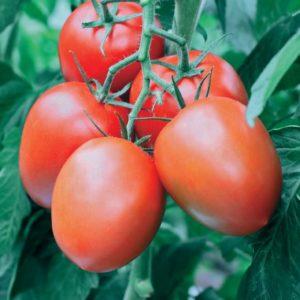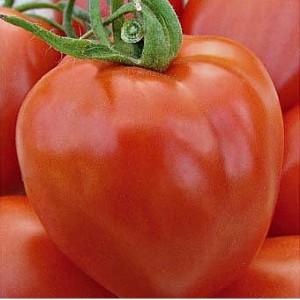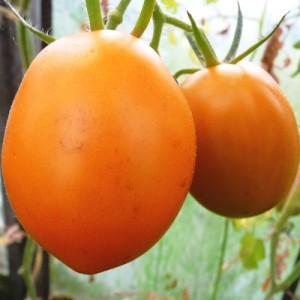Guest in the garden named after the star: Canopus tomato
This tomato variety gets its name from a star from the Southern Hemisphere. Canopus is a yellowish-white star, a supergiant in the sky, captivating with a magical light, and in the garden there is a special kind of tomato that organically combines excellent taste with ease of care.
Tomato Canopus comes from Siberia (from Novosibirsk), therefore, it is quite suitable for the difficult conditions of the Siberian summer and other regions that differ little in climatic conditions. However, he takes root well in greenhouses. Refers to determinant, as it has limited growth.
The content of the article
Tomato Canopus: variety description
Bushes of this type are compact in size, their height is 50-60 cm. Leaves are medium in size, traditional in shape, rich dark green color. During the flowering period, many simple inflorescences appear. The first inflorescence is laid over 6-9 leaves. The next one is at a distance of 2-3 leaves from the previous one.

The culture belongs to mid-season tomatoes. Fruit ripening occurs 110-120 days after planting. Their shape is oblong or almost oval, similar to a cylinder (as they look, you can see in the photo), the sizes are average. The smooth surface of the skin changes to a folded one at the base of the peduncle. The color is bright red when ripe, each fruit has more than 4 seed chambers.
The fruit tastes good, but like the size, it depends on the growing conditions. Versatile in preparation: good for salads, they make excellent tomato products (juice, ketchup, adjika), suitable for pickles and marinades.
In terms of yield, the variety can be attributed to the tomato record holders. It is for this reason that he attracted the attention of those who put tomatoes up for sale.... On average, from 1 sq. m collect up to 4 kg of finished products of commercial quality.
How to grow seedlings
Strong seeds are selected for planting without any damage. Before planting, the seeds are soaked and disinfected. They are sown in a common wooden box in pre-made shallow grooves at a distance of 4 cm from each other. Before planting seeds, the soil is loosened and disinfected.
Do not forget about maintaining regular humidity: the easiest way to do this is with a spray bottle. The optimum air temperature is at least 25 degrees. Also, the seedlings should not suffer from a lack of light, so in the daytime the containers are placed on the windowsill, and in the evening they add backlighting with fluorescent lamps.
After 60 days, the seeds turn into young bushes, ready for transplanting into open ground.
Important! This variety of tomatoes needs a pick.
A pick is a transplant of seedlings from a container common for all seedlings into individual pots (plastic cups). Accompanied by truncation of the main root by 25-30% of the length.
How to grow tomatoes
Before planting seedlings, you should take care of the soil in advance. You should not plant a tomato in the area where potatoes grew a year earlier. But the earth after cucumbers, zucchini and pumpkin is fine.
Tomatoes grow best in loose soil with adequate moisture. An acidic environment is inappropriate here, only a neutral one will do. The condition of the soil is checked using a litmus test: if the value is more than 6.5, then lime or dolomite flour must be added to the soil to reduce acidity.
The Canopus variety responds well to the introduction of either organic or mineral fertilizers. Organics have a beneficial effect on plant growth and attract earthworms.In this case, oxygen will be provided. But it should be borne in mind that moles like to feast on earthworms, so their excess may not be beneficial, but harmful.
Important! You can not get carried away with fertilizers, as you can burn the shoots. An excess of fertilizers is also harmful because the plant will go into the leaves, and the fruits will be small and inconspicuous.
Despite the small growth, the garter of the bush is necessary, since a considerable number of fruits are tied on the branch and the plant breaks from its own weight. If we are talking about an industrial volume, that is, a large number of bushes, then it is quite possible to do without a garter, collecting ripe vegetables from the surface of the earth.
Watering held no more than once a week. Do not forget that any varieties of tomatoes do not like waterlogging. Excess moisture negatively affects the quality of the crop.
Loosens the soil as needed. Removing weeds helps oxygen to reach the soil.
Diseases and pests
The tomato record holder is genetically immune to the tobacco mosaic virus and resistant to late blight. However, this disease rarely affects vegetable crops.Late blight, or brown rot, develops in wet weather, and in dry weather, its development stops. The leaves are affected first, and then the fruits.
There are two methods for salvation from this disease - chemical and folk:
- Furacilin treatment (chemical method). The solution is prepared immediately for the whole summer. In 10 liters of water dissolve 10 crushed tablets "Furacilin". Sprayed three times a season: before flowering, when the first ovaries appear, when the first tomatoes ripen.
- Soda treatment (folk method). Dissolve 1 tablespoon of soda in half a bucket of water. Spray every week.
- Processing with vinegar (folk method). 0.5 cups of 9% vinegar are diluted in one bucket of water. The whole plant is sprayed once every 10 days or after rain.
Due to the harsh smell, many pests bypass the variety, but the bear is terrible for Canopus. She lives underground, damaging the roots of seedlings, which subsequently die. Medvedka is frightened off by the smell of fish and garlic, so it is enough to bury fish heads or garlic cloves in the beds. Also, the bear does not like the smell of marigolds and keeps away from these flowers.
The nuances of growing in open ground and in a greenhouse
When grown in open field, the culture does not need formation or pinching.
For those who want to increase the number of tomatoes on their plots, a number of the following activities are proposed:
- soil mulching;
- protection against spring frosts;
- treatment of seedlings with growth stimulants;
- placing plants that repel pests near a vegetable crop.
In greenhouse conditions, the plant is best formed into two stems. This allows you to achieve the maximum effect on fruiting and ripening time. In greenhouses for the same purposes, the bushes are stalked.
The mass of one fruit ranges from 120 to 180 g. But knowing and using special techniques (formation, pinching, obtaining the required amount of light and moisture, feeding), it is quite possible to get fruits weighing up to 400 g each.
Harvesting and application of the crop
Since the tomato is mid-season, it ripens by the end of summer. The main thing is to make sure that the fruits do not overripe, otherwise, being heavy, they can break bushes... If, due to the large grown volume, the bushes are not tied up, the tomatoes are harvested from the ground. In this case, it is also necessary to monitor maturity, otherwise they will crack and rot from overripe.
The fruits are distinguished by their excellent presentation, long storage and good transportability. However, this is not surprising when you consider that it is this species that is preferred as a culture that generates income through sales.
These vegetables are versatile in cooking - they are good both fresh and in preparations for the winter.
Advantages and disadvantages
Like the Star Canopus, the vegetable culture named after it has its light and dark sides.
Let's consider the positive characteristics first:
- unpretentiousness in growing;
- resistance to many diseases and pests;
- high quantitative indicator;
- possible large fruit sizes;
- their unusual shape;
- presentation and long-term storage, good transportability;
- productivity in any regions of the country;
- versatility in cooking.
There are many times less negative sides, but they are available:
- the dependence of the qualitative characteristics of the fruit on the growing conditions;
- garter bushes;
- average ripening rate.
Farmers reviews
The following ratings are collected from different cities, but despite the weather conditions of different regions, this vegetable crop pleases tomato lovers equally.
Antonina, 52 years old, Yaroslavl: “They advised the seeds of a new kind of tomato in the store. I grew them in a greenhouse, I really liked them. There were many fruits on each bush. They are tasty, fleshy, aromatic. I twisted tomato juice out of them for the winter, made adjika, lecho and other preparations. And so they are very good in salads. The next year I collected seeds, I will definitely grow from my seeds. In all respects - a wonderful variety! "
Victor, 63 years old, Izhevsk:“Canopus is the ideal species for beginners or lazy gardeners. I practically did not water or fertilize, but still I am satisfied with the result. Of course, the variety pleased with its high yield. At the same time, it is possible to obtain large and very tasty fruits. "
Germislav, Magnitogorsk:“I have been dealing with this tomato for three years. I sow seeds in the second half of March. When three true leaves appear, I make a pick, placing each plant in a separate glass. Then I place the seedlings in open ground. After 10 days, I water it using fertilizer for seedlings. After another two weeks, I water it with urea. I am feeding the third time using fertilizers with microelements. The result is excellent. "
Conclusion
Few varieties are suitable for both experienced farmers and novice summer residents. But the described variety is exactly that, for which it received general honor and respect.
Many farmers opt for this crop because of its ease of care, resistance and high quality and quantity. Also, an important role is played by the universal survival of this species in any climatic zone, once again proving its origin from the harsh Siberian region.